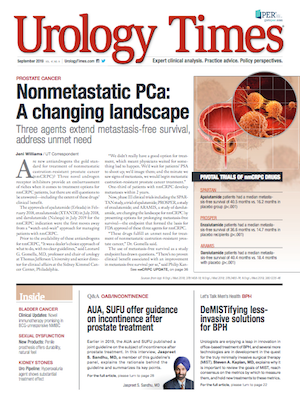Publication
Article
Urology Times Journal
Mental QoL similar in PCa patients opting for AS vs. definitive treatment
Author(s):
A survey of low-risk prostate cancer patients found men who choose active surveillance over definitive treatment have similar mental health outcomes.
A survey of low-risk prostate cancer patients found men who choose active surveillance over definitive treatment have similar mental health outcomes.
“This debunks the myth that active surveillance would cause undue anxiety due to untreated cancer in the body,” Christopher C. Randall, a second-year medical student at University of Arkansas for Medical Sciences in Little Rock, told Urology Times.
A study by Randall and colleagues, presented at the AUA annual meeting in Chicago, sought to explore the impact of active surveillance on quality of life in men with low-risk prostate cancer.
Most men who are diagnosed with low-risk, localized prostate cancer choose immediate treatment, Randall says, including prostatectomy, radiation therapy, and hormone therapy. While these treatments are effective in treating the disease, they also cause side effects such as urinary incontinence, uncontrollable and painful bowel movements, and decreased energy.
Also see: Sipuleucel-T cost lower vs. oral drugs over time
However, recent research shows the number of men who are opting for active surveillance is significantly increasing (JAMA 2019; 321:704-6). Given that most men who are newly diagnosed with prostate cancer have a Gleason score of 6 or less, which puts them at low risk of developing life-threatening cancer, quantifying the impact of active surveillance on patients’ overall quality of life is important. However, little data around the physical and mental health impact of active surveillance exist beyond the avoidance of side effects from aggressive treatment.
The authors mailed surveys to 370 patients identified through the Arkansas Central Cancer Registry as having low-risk prostate cancer, following up by phone with patients who did not respond. The surveys consisted of the Veterans RAND 12-Item Health Survey and supplemental questions, including age at diagnosis, education level, the patient’s level of trust in his urologist, and the extent to which the patient was included in the treatment decision.
Then, the authors developed a multivariate regression model that adjusted for these variables to determine the impact of active surveillance on mental or physical health outcomes. Thirty-seven percent of patients responded to the survey.
“What was surprising is that just 57% of patients recalled being offered active surveillance,” said Randall, who worked on the study with Rodney Davis, MD, and colleagues. Among those who were offered active surveillance, 37% chose it as an initial management option.
Next: AS patients more likely to report better physical QoLAS patients more likely to report better physical QoL
Patients who underwent active surveillance were 12 times more likely to report better physical quality of life than definitive-treatment patients, including general health, physical functioning (eg, moderate activities, climbing stairs), decreased role limitation (eg, limited in activities), and pain. This is likely due to the absence of treatment complications in this group.
They also scored higher on mental quality of life, but only one of the scores in this area-vitality-was statistically significant.
Read: Researchers develop noninvasive biomarker for aggressive PCa
“The degree to which patients trusted their physician corresponded positively with their mental score,” Randall said. For example, patients who “strongly agreed” that they trusted their physician had higher average mental quality of life scores than those who did not.
Continued analysis of the results demonstrate better quality of life outcomes in low-risk prostate cancer patients electing active surveillance, Randall said.





























